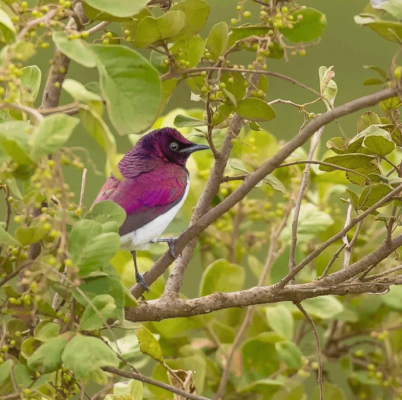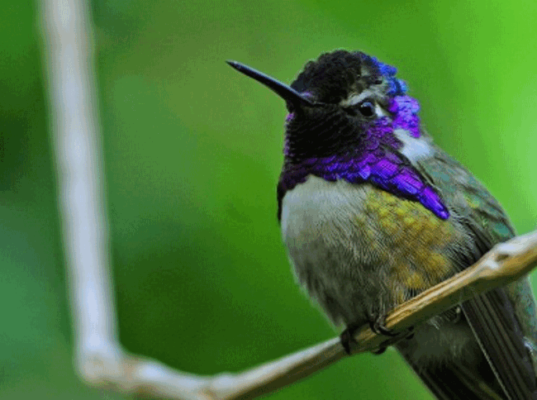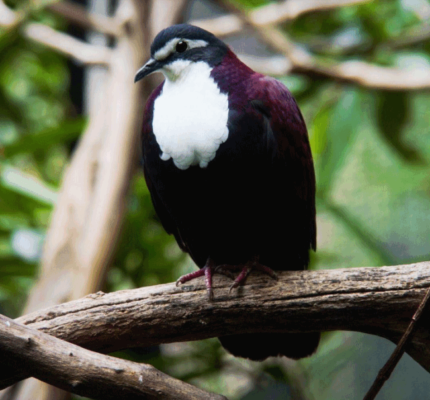There are many different types of birds in the world. Some are very colorful, while others are more subdued in color. Purple and white birds are beautiful examples of birds with stunning colors. These birds can be found in many different habitats. They are also a popular choice for birdwatchers and pet owners alike.
Below we’ll explore 10 white and violet birds that you can spot on your next birding tour. Know what to look for easy identification; their color, size and as extra, their feeding and breeding habits.
- Plum-colored Starling

The plum colored starling is a beautiful bird that is also known as the amethyst starling or violet-backed starling. Found in parts of Sub-saharan Africa, this medium sized bird has very distinctive features.
Identification:
These birds are not only stunning to look at, but they are also interesting creatures. Male violet-backed starlings have an iridescent purple back and a pure white belly.
On the other hand, females are duller and easy to miss. The female plum-colored starling has a streaked brown back and a whitish belly. Both sexes are 7 inches in length.
According to birders at SpanishBirdGuides, these purple and white birds are found in forests and woodlands. The bird feeds on insects, berries, and fruits. The bird nests in tree cavities.
Like other birds in the starling family, violet-backed starlings are able to mimic other bird species.
- Purple Azure Tit
The Azure Tit is a stunningly blue songbird found in forests throughout Central Asia. Though not migratory, this little bird is constantly on the move within its territory, foraging for insects in the trees and shrubs.
Identification:
The adult Azure Tit is especially striking. Both sexes are the same length and have similar plumage. Depending on the region, these small birds can be white and dark blue or white and purple.
Both morphs spot a white head and a black eye mask. They are about 5.5 inches long.
Purple azure tits are cavity nesters, preferring to nest in tree cavities. They lay whitish spotted eggs that take about two weeks to hatch.
This small but vibrant bird is a joy to watch, and with some basic bird-watching equipment, you can easily add the Azure Tit to your watched list!
- Purple Martin (Female)

Ranging from North America to South America, purple martins are the largest members of the swallow family.
Identification:
These birds get their name from their plumage, which is a deep purple hue. Male and female purple have slightly different plumage.
The male has a dark hue while females have a duller purple hue and are whitish underneath.
Purple martins are found in open areas near water, such as marshes, ponds, and streams. They build nests out of mud and twigs and line them with grasses. Purple martins typically lay 4-6 eggs per clutch.
These birds are insectivores and eat a variety of flying insects, including mosquitoes, beetles, and wasps. Purple martins use their long tongues to capture prey in mid-air.
- Cameroon olive pigeon
The Cameroon olive pigeon is a species of bird in the family Columbidae. The pigeon is endemic to Cameroon.
Identification:
The Cameroon olive pigeon is a medium-sized pigeon with a length of 9-9.8 inches. The bird is overall purple with white spots on its back and breast. Notice the bright yellow-tipped bill. They have round wings and a long tail.
The diet of the Cameroon olive pigeon consists mainly of fruits and seeds. The bird breeds in forest habitats and nests in tree holes or crevices. These purple and white birds are known for their low coos.
- Tufted jay
Tufted jays are striking birds that are endemic to Mexico. This majestic bird prefers pine-oak forests.
Identification:
They are easily recognizable by their purple-blue back and white plumage on the belly, back of the head and half their tail. Their faces are black with white cheeks and stunning black crests.
They are very social birds and often form flocks of up to 100 individuals. Tufted jays are known for their loud calls. During breeding season, the female tufted jay builds a nest on shrubs or thorny bushes. She will then lay 3-5 eggs that she incubates alone.
- Costa Hummingbird (Male)

Cute and small, the Costa hummingbird is a species of hummingbird that is found in the Pacific coastal regions of North America. The bird is named after the Italian explorer and naturalist Giovanni Maria Costa, who was the first to describe the species in the 1800s.
Identification:
The Costa hummingbird is a small bird, with a body length of only 3-4 inches. Males have a purple face and throat feathers that extend to the side. Underneath they are whitish and greenish above. In contrast, females are greenish and grayish below.
The tail of the Costa hummingbird is relatively short and straight, with a rounded edge.
The Costa hummingbird is known for its high-pitched call, which sounds like a metallic ‘tink’ noise. The bird is also known for its rapid wing-beat, which can reach up to 80 beats per second.
- White-browed Tit-Warbler
The white-browed tit warbler is a small songbird that is found in the forests of Central China.
Identification:
The male of this bird species has a chestnut head, noticeable white brows, and a purplish-gray body. Females are grayish-brown with a chestnut cap. They have hints of purple under their wings.
The bird breeds in April to July. The nest is built in a tree or bush, and usually contains four eggs.
The white-browed tit warbler is not considered to be threatened at this time.
- White-breasted Ground Dove

White-breasted ground doves are a species of bird in the Columbidae family. It is a resident breeder in New Guinea.
Identification:
The white-breasted ground dove is a medium-size bird, with a length of 10 inches. The plumage is overall dark gray with a purplish sheen on their wings, shoulder, and upperback. It has white eyebrows, throat and chest. The bill is black, and the legs are pink.
The white-breasted ground dove inhabits open areas with some bushes or trees. The bird typically forages on the ground for seeds, but will also eat insects.
- Western Violet-backed Sunbird
Western violet-backed sunbirds are small purple and white birds of Africa.
Identification:
The male sunbird has violet upperparts and a white underbody. Its wings are dark brown. The female is brown with some yellow on the sides. These birds are found in forests and woodlands, where they feed on insects and nectar.
The western violet backed sunbird is a relatively new species to science, first being described in the 1800s. Not much is known about their ecology or behavior, but they are thought to be non-migratory. These birds are important pollinators of many native plants and play an important role in the African forest ecosystem.
Leave a Reply